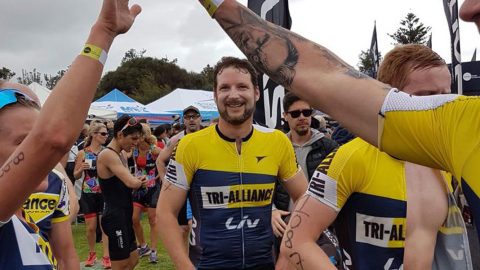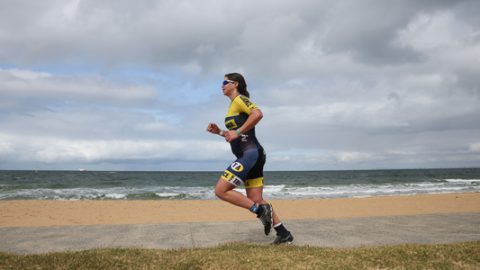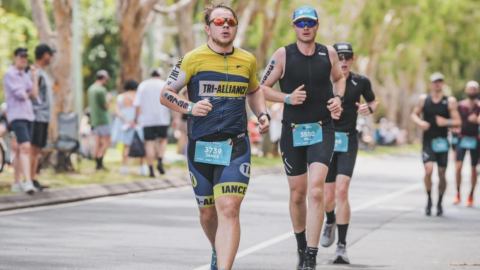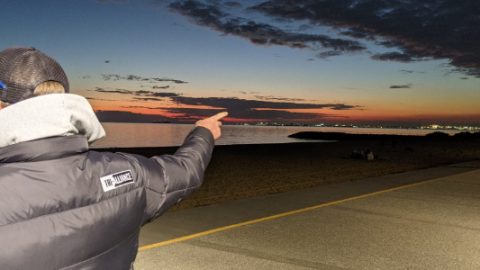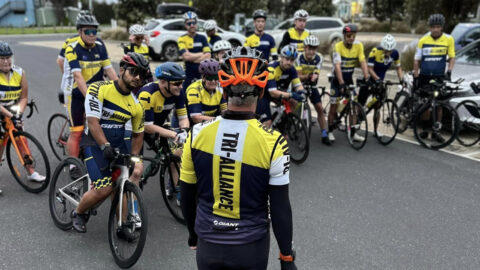WEEKLY TRANSITION, SWIM, BIKE, RUN, READ…..
- WORD FROM THE COACHES
- SKILLS FOR THE OFF-SEASON
- THAILAND TRAINING CAMP
- RIDING THE HILLS
- TRAINING SESSION UPDATES
 The weekend saw another first for many athletes with a fresh ride to Kinglake working the hills. A dedicated bunch set out from Studley Park navigating out to the countryside through some great scenery. The climb itself is a good challenge and is sometimes rewarded with views back over Melbourne (maybe next time…?) This Saturdays ride will again be a first for many with a new route out around Sunbury and Oaklands Junction just North of the Airport. This gives those living north or west easier access and makes for a different hill ride. We will be back to the Dandenongs and Kinglake in the weeks to come but will be rotating through these locations to vary it up and give specific purpose to each ride. For more details see below.
The weekend saw another first for many athletes with a fresh ride to Kinglake working the hills. A dedicated bunch set out from Studley Park navigating out to the countryside through some great scenery. The climb itself is a good challenge and is sometimes rewarded with views back over Melbourne (maybe next time…?) This Saturdays ride will again be a first for many with a new route out around Sunbury and Oaklands Junction just North of the Airport. This gives those living north or west easier access and makes for a different hill ride. We will be back to the Dandenongs and Kinglake in the weeks to come but will be rotating through these locations to vary it up and give specific purpose to each ride. For more details see below.
A gentle reminder that key to enjoying these long rides and getting the most from them is to dress adequately for the conditions and ensure that you fuel and hydrate before and during the ride so energy levels do not drop too much on the last bit.
THAILAND CAMP – ONLY 5 SPOTS LEFT!
With more booking coming in over the past couple of weeks and more getting flights and deposits sorted we have a limited number of spots left for our awesome international camp coming up at the end of July. Bike fit, 3 meals a day, sweat testing, top quality facilities, video analysis – for all the details on this camp click here
SWIMMING SESSIONS
 We have had great numbers at our swim sessions recently and can see progress through the squad. We have been working a great deal of technique with drills taking up a large amount of time – these will make you a better and stronger swimmer and will continue through the winter. In addition to this we are going to be working on tumble turns…..push ups for those who don’t try. Yes we don’t tumble in the open water in a race but look at the bike – we do ride in groups – most races are not draft legal so why? Learning bike control, skills and pacing and often pushing us beyond what we though possible. So tumble turns are of benefit too – they give you uninterrupted swimming, better breath control and improve your technique and body awareness. We rest our case – tumble turns from now on!
We have had great numbers at our swim sessions recently and can see progress through the squad. We have been working a great deal of technique with drills taking up a large amount of time – these will make you a better and stronger swimmer and will continue through the winter. In addition to this we are going to be working on tumble turns…..push ups for those who don’t try. Yes we don’t tumble in the open water in a race but look at the bike – we do ride in groups – most races are not draft legal so why? Learning bike control, skills and pacing and often pushing us beyond what we though possible. So tumble turns are of benefit too – they give you uninterrupted swimming, better breath control and improve your technique and body awareness. We rest our case – tumble turns from now on!
GATORADE SERIES 2016/2017
 Dates have been released for the new Gatorade Triathlon Series which follows the same pattern as the very successful events of last year. With 2 races and Elwood, 2 at St Kilda and the 31st running down in Portarlington. Entries open on the 5th August with more information being released soon. checkout their website here and ensure you subscribed to their Facebook page for event updates here. We are getting super pumped already to be involved with this series and are looking forward to racing at Elwood come November. Make sure you get the dates in the diary now to avoid any clashes!
Dates have been released for the new Gatorade Triathlon Series which follows the same pattern as the very successful events of last year. With 2 races and Elwood, 2 at St Kilda and the 31st running down in Portarlington. Entries open on the 5th August with more information being released soon. checkout their website here and ensure you subscribed to their Facebook page for event updates here. We are getting super pumped already to be involved with this series and are looking forward to racing at Elwood come November. Make sure you get the dates in the diary now to avoid any clashes!
Race 1 – Elwood – 27th November 2016
Race 2 – St Kilda – 8th January 2017
Race 3 – Elwood – 5th February 2017
Race 4 – Portarlington – 12th March 2017
Race 5 – St Kilda – 26th March 2017
WINTER CLOTHING – SALE

 With the cold hitting recently we have had a run on winter jackets, vests, arm warmers, leg warmers and anything we have to keep warm! We still have a number of items and sizes in stock but will not be ordering anymore in this winter so grab them now before we run out. Jackets $60, Vests $40, Arm warmers $17.50, Headband $16, Scull cap $20
With the cold hitting recently we have had a run on winter jackets, vests, arm warmers, leg warmers and anything we have to keep warm! We still have a number of items and sizes in stock but will not be ordering anymore in this winter so grab them now before we run out. Jackets $60, Vests $40, Arm warmers $17.50, Headband $16, Scull cap $20
Check out the full range and order online here.
TRIATHLON VICTORIA MEMBERSHIP – RENEWALS THIS WEEK
As an affiliated club, Triathlon Victoria requires that all our members all also have current memberships with themselves. When signing up for Tri VIC a club discount is offered when selecting Tri-Alliance. The renewal of memberships are due at the beginning of July (Friday!) and we have confirmed and submitted with Tri VIC who is not actually a current paying annual member with Tri-Alliance. If you are not then for the forthcoming year the discount will not apply or your membership with Triathlon Victoria will not automatically renew. Please ensure you are both current with Tri-Alliance and Tri VIC as these memberships cover racing and training insurances. Please note that it is your responsibility to manage your annual memberships and direct debits – reminders are sent from both TriVic and Tri-Alliance. We will be charging an admin fee of $20 should any refunds be requested after renewals are made for Tri-Alliance annual membership.
TIMETABLE UPDATES
July’s timetable and programs have been uploaded so please have a scan over the sessions to ensure you know where and when they are. Any questions please email us at [email protected].
Well done to all who completed their swim and run time trials last week – both were about as wet as each other! Tonight at our MSAC wind trainer session we will have the repeat of the bike ftp set to see how our heart rate and power zones are tracking. Please arrive early as we will start bang on 6:15pm to get the whole set in. Ensure you bring your HR monitor if you have one and fuel and hydrate well during the day prior to the session.
Reminder that MSAC swim sessions have returned to 1hr duration with Wednesday and Friday mornings starting at 6am. Tuesday morning runs are also now from 6am.
Please can athletes arrive on time and be ready for the start of each session. If you miss the beginning you may miss important information regards the session, the warm-up and briefing. This can also disrupt other athletes who have arrived on time and begun their session already. Please do ensure you check the timetable and our Victorian Facebook page for training sessions and updates.
A recent article on Triathlon Australia’s web site from their partner Training Peaks reflects exactly what we have been focusing on in our off season. We have been working with our athletes on their stroke and drills in the pool, single leg and low cadence pedal efficiency drills on the bike and correct form at run sessions. Have a read of the below and take note that what we are doing now forms the basis for the rest of the season and is that base layer on which all else will be built. Crucial to get these right now so make sure you are coming along to the all important swim, wind trainer and run skills sessions.
After a long year, the body and mind do need a bit of a break, or change in focus. Top athletes are always looking for opportunity to improve. The goal of the adult athlete is to improve, which means getting faster, stronger, smarter, and more skillful. Rather than continuing to push hard day in and day out, use this precious window of time to work on skills. With the three different disciplines in triathlon, there are plenty of areas to work on. As adults, the acquisition of a new skill is a huge boost to confidence. Here are some focal points for you.
Swimming
Interestingly, I recently had a conversation with a well-respected Olympic Swim coach, who mentioned that the most important innovation in swimming in the last 50 years was the advent of the pace clock. All swimmers use a pace clock. Do you? If not, how do you know if you are swimming faster if you don’t know how fast you are swimming? Learning to swim specific paces teaches a cognitive association between a number (time) with feel, flow, and momentum. An experienced swimmer can tell you how fast they did their last 100 without even looking at the clock because they have been timing their paces for so long. Using the pace clock, not the watch on your wrist, is great way to learn even pacing and rest. Peek at the pace clock each 100 just after your turn to recognize whether you should slightly adjust for going too fast or too slow. Learn how to incorporate the pace clock with set “leave” times in your workouts. To do this, you would say, “I am going to swim 6 x 200 on a 4:00 leave time, averaging 3:30. When I peek at the clock at 100m I will look for 1:45.”

Rather than trying to get faster, initially aim to be consistent in your swim times. Start with shorter distances like 50s and 100s, and then progress to longer distances like 200s and 400s. The shorter the distance, the closer the times should be. Keep all intervals within 3 to 5 percent.
Additionally, most adult swimmers need to focus on two main technical areas: propulsion and body position. Improve either of these and you will go faster.
Always include some drills in warmup that aim to develop a better catch. 25m of front scull with a high elbow followed by 25m of swimming with a long smooth stroke and strong pull is a good choice. This reinforces a high elbow catch and feel for the water.
Commit two months to D.P.S. (Distance Per Stroke). For different intervals, count your strokes while timing yourself for a portion of every swim. First, spend two weeks reducing your stroke count by pulling more water harder (not pausing between strokes). Second, spend six weeks maintaining that stroke count over gradually longer distances or reducing your time at that same distance and same stroke count. These are both gauges of increased stroke efficiency. Either way you are travelling further with every stroke.
An indication of good body position is low head, shallow read-end, and your heels just breaking the surface of the water during your kick. Practice kicking without a board for 25m on your stomach, and on either side, rotated 45 to 60 degrees for the 25m. Focus on looking straight down at the bottom of the pool between breaths, instead of forward. When breathing, keep body roll efficient by only looking to the pool gutter rather than the ceiling or bleachers. Focus on one or two elements of body position per workout rather than everything at once.
Cycling
Improve your future performance by including trainer workouts that challenge different aspects of pedal stroke.
For strength and power, focus on sets at 50 to 65rpm with high pedal force and low heart rate. This also slows your pedal stroke allowing you to focus on engaging the full circumference of the stroke, not just the downward push on the pedals. Think of pushing “up and over” the top of the stroke, or “scraping mud off the bottom of your shoe” through the top and bottom of your pedal stroke. As an added challenge, increase to 90rpm at high effort for the final minute to simulate cresting the top of a hill.
To encourage smooth and proficient pedaling, and efficiency maintaining pressure on the pedals for tailwind or downhills, aim for 120 to 140rpm. Begin with short intervals of 15 seconds and increase by that amount until you reach two or three minutes. The goal is to do this workout without bouncing on the saddle.
Last, do single-leg drills to improve individual leg pedaling efficiency. Ride at 70 to 90rpm with one leg clipped in, the other unclipped against you seat stay. Start with 15 seconds and work your way up to two minutes. If you are finding this daunting or difficult, envision the para-triathletes riding an entire Ironman course with one leg.
Running
One common skill that many athletes need to work on is posture. The goal is to have a straight line pass through the head, shoulders, hips and ankles, with a slight lean forward. A common mistake is letting your hips drop as you fatigue, resulting in running in an upright seated position. The cause can be as simple as a weak core or a lack of awareness. During base runs and on the hills consciously think about keeping the hips forward and over top of the foot strike as you run. Run with your head high and proud, and your eyes scanning the ground about 30m in front of you. Finding a 200 to 400m stretch with a slight downhill grade of one percent is a great place to work on posture. Lean slightly forward from the hips and chest, and run at 10k race pace for short stretches.

Run cadence is an important factor in run economy as well. I have coached seasoned runners to personal bests by simply refining their stride rate. They find they have better second halves in their run races as they are not fatigued from over-striding during the first half. Quantify cadence for all runs and all paces. Keep cadence higher that 90 strides per minute (counting one leg only). Count one single leg for 30 seconds with a goal of 45 or more foot strikes regularly through your runs, or better yet, invest in a watch (Timex, Polar, Garmin, etc.) that has cadence measuring technology.
This is a short list of small changes that can be made easily when there is no pressure to perform. Use the off season to work on a skill or technique before training begins in earnest.
3.THAILAND TRAINING CAMP – ONLY 5 SPOTS LEFT
Thanyapura Triathlon Training Camp Thailand 7 days all inclusive $1600.
Ideal prep for Kona Ironman, Sunny Coast 70.3 and ITU Mexico World Championships! 30th of July to the 7th of August. All inclusive!
The Thanyapura Triathlon Training Camp Thailand (Advanced Camp) this year is one not to be missed! We have tailored this camp for the upcoming Ironman World Champs (Kona), Sunshine Coast 70.3 and Cozumel ITU World Championship events, as a lead-in for Kona Ironman or as a springboard to the 2016/17 season.
- Accommodation (twin share)
- 3 meals a day
- Sweat testing, Fluid and Calorie loss (Valued $250)
- Video Analysis for Swim, Bike and Run (Including underwater swim analysis Value $450)
- Retul Bike Fit (limited to the first 20 signed and paid up Value $295)
- Nutritional Seminar with Darryl Griffiths author of Sweat, Think, Go Faster and owner of Shotz Sports Nutrition
- Action-packed timetable of Key Sessions to ensure a solid training spike in your fitness guaranteed
NB: Flights are not included in this price
This initiative was born from the need of many athletes who are looking to take their training and racing performance to the next level. For those who need to include a spike in their program, get some real marginal gains and advance themselves as an athlete through true immersion in triathlon training in a world class facility.
For full details and bookings click here.
 For the next few months most weekends our athletes will be taking their riding into the hills around Melbourne. This specific training is to build strength over winter and a great base for the endurance and speed work to come much closer to race season. Working that big gear and fighting the forces of gravity not only builds muscle but gives the mind a workout in pushing the boundaries and breaking new ground. Whether it be your first time up the 1 in 20 in the Dandenongs or Kinglake or Macedon there is a hill with your name on it and the more you do the better you will become. Embrace the hill!
For the next few months most weekends our athletes will be taking their riding into the hills around Melbourne. This specific training is to build strength over winter and a great base for the endurance and speed work to come much closer to race season. Working that big gear and fighting the forces of gravity not only builds muscle but gives the mind a workout in pushing the boundaries and breaking new ground. Whether it be your first time up the 1 in 20 in the Dandenongs or Kinglake or Macedon there is a hill with your name on it and the more you do the better you will become. Embrace the hill!
So even when it is cold (and possibly damp) get those layers on and get out into the hills as you will become a better athlete because of it. The camaraderie seen on recent rides has been amazing with people encouraging each other up the inclines and coaching them down to ensure all are safe and sound at the end.
For a great site on reviewing hill climbs check out The Climbing Cyclist – a guide to Victoria’s best climbs.

Please ensure you check the calendar regularly to know where and when sessions are as they do sometimes change (this is especially true for swim sessions at MSAC as these can change and are often unfortunately beyond our control). This weeks highlighted sessions: (please ensure you check your program or consult a coach so you attend the appropriate session and that you know your distances – remember you are accountable too!). When out riding please do so safely and pay attention to all the road rules and others using the road. Read on for a guide to cycling etiquette and bike road safety and ethics.
- Tuesday 28th June – Wind Trainer Test session – HR/Power. Be there for a 6:15pm prompt start.
- Thursday 30th June – Run – 6:15pm @ the Tan and 6:30 @ Essendon
- Saturday 2nd July – Long Rides
- Intermediate and Advanced Groups will be heading from Oaklands Junction just North of the Airport (the runway viewing area) on a loop with Coach Ollie rolling at 6:30am.

- Beginners and those returning from injury or racing there will be a ride rolling from Elwood at 630am along Beach Road with Coach Scott.
- Sunday 3rd July – MSAC Run @9am, Fairfield Run @8am
When riding on a Tri-Alliance coached road ride it is a requirement to wear team colours. This helps keep and identify the group together and provides more safety in the fact that other riders from outside the group are less likely to join in the group – we do not know them or their riding abilities.


